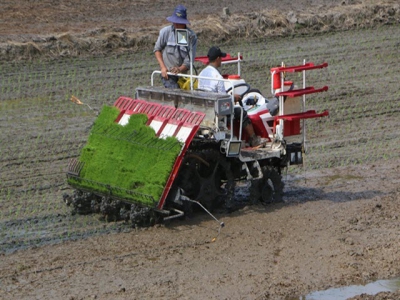Mekong Delta embraces smart rice farming

Ho Chi Minh City — The Cửu Long (Mekong) Delta’s 12 provinces and Cần Thơ City are increasingly switching to smart rice farming to improve yields and cut costs and protect the environment.
Transplanting rice seedlings under a smart rice farming model in Hậu Giang Province’s Vị Thắng District. – VNA/VNS Photo Duy Khương
They use fewer seeds and less pesticides and fertilisers compared to traditional farming methods without losing out on yield or quality.
Smart rice farming also involves the use of advanced technologies like smart rice seeding and transplanting machines and other smart devices.
Hậu Giang Province adopted the model on 12ha of rice belonging to 12 farmers in Vị Thủy District’s Vị Thắng Commune in April.
The farmers use seeding and transplanting machines integrated with smart fertiliser applicators and pesticide sprayers. These can sow rice seeds or transplant rice seedlings, bury smart fertilisers and spray pesticides at the same time.
The model uses fertiliser deep placement method, which involves placing fertiliser briquettes under the soil.
Phạm Minh Quang, one of the 12 farmers, grows 2ha of rice. He said the briquettes release the fertiliser gradually based on the plants' requirements during the growing period so that they do not suffer from an oversupply of urea and thus diseases.
“I had to pray pesticides just once since the beginning of this rice crop to prevent rice blast disease.”
Phan Văn Bình, head of the Vị Thủy Plant Protection Division, said the model would help protect the environment since it reduces the use of urea.
The fertiliser deep placement method is used only once during the crop when sowing the seeds, he said.
The use of pesticides also reduces significantly and rice planted under the model can grow more naturally, he said.
Nguyễn Văn Kính, chairman of the Vị Thắng Commune People’s Committee, said the district is co-operating with relevant units to monitor the model, and it would be expanded in the district if it proves efficient.
Effectiveness
In Đồng Tháp and Trà Vinh provinces, farmers have used smart rice farming to good effect. Their use of urea has declined by around 40 per cent and the cost of labour for fertilising their fields by 75 per cent.
Fertiliser deep placement has helped reduce greenhouse gases by 40 per cent when used with alternate wetting and drying irrigation.
Smart farming reduces the amount of water required for irrigation by 30 per cent and the labour cost and seed requirement by 50 per cent.
It also reduces saltwater intrusion into rice fields since farmers can actively regulate freshwater through smart devices that monitor the quality of water.
The profit from this model is 20 per cent higher than from traditional methods, according to farmers.
Nguyễn Văn Khi, a member of the Thắng Lợi Agricultural Services Co-operative in Đồng Tháp’s Tháp Mười District and who has used smart rice farming for three years, said irrigation water is regulated by smart devices operated through smart phones.
Đồng Tháp is seeking to reduce rice production costs and improve quality and expand farming models that use advanced technologies, especially the smart rice farming model in Tháp Mười, according to its Department of Agriculture and Rural Development.
In Tiền Giang Province, the Agriculture Extension Centre encourages farmers to expand smart rice farming that uses smart rice seeding and transplanting machines integrated with smart fertiliser applicators and pesticide sprayers.
It recently introduced this model in Cái Bè and Gò Công Đông districts and achieved good harvests.
The Mỹ Quới Agricultural Service Co-operative in Cái Bè grew 1ha of rice using the model in the spring-summer crop this year.
It sowed 50 kilogrammes of OM 5414 rice seeds and harvested 6.6 tonnes per hectare, 0.8 tonnes higher than under traditional models, which used up to 150kg of seeds.
Trần Thị Cẩm Nhung, deputy head of the centre’s technology division, said the co-operative’s members earn VNĐ4.7 million (US$200) per hectare more than traditional farmers.
The National Agriculture Extension Centre, the Southern Plant Protection Centre and agriculture extension centres around the delta have been running a smart rice farming programme to adapt to climate change since 2016.
Under it, the delta’s 12 provinces and Cần Thơ have tried 195 different models so far.
The delta, the country’s rice granary, has nearly 1.7 million hectares of rice fields, with 300,000 – 400,000ha affected by saltwater intrusion through rivers in the dry season.
Related news
 Smarter ways to irrigate sugar cane
Smarter ways to irrigate sugar cane This prompted Dr Abraham Singels, principal agronomist at the SA Sugarcane Research Institute, and his colleagues to begin researching options aimed at maximisi
 Phu Giao’s economy continues taking fruits
Phu Giao’s economy continues taking fruits Phu Giao district’s economy in the first months of 2019 still reached good results, despite bad weather and African hog cholera outbreak in some breeding
 Việt Nam becomes second largest exporter of lychees
Việt Nam becomes second largest exporter of lychees Việt Nam has become the second largest exporter of lychees in the world, accounting for 19 per cent of the global market share